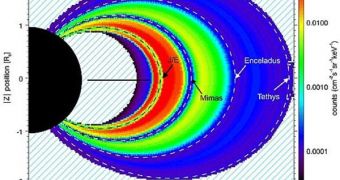Astronomers and physicists analyzing the data relayed back by the Magnetospheric Imaging instrument (MIMI) aboard the Cassini spacecraft have recently discovered a new, transient radiation belt around Saturn. Located some 337,000 kilometers away from the planet's core, the belt is located roughly around the moon Dione. Dr. Elias Roussos will present the discovery today, September 14th, at the European Planetary Science Congress, in Potsdam, Germany, AlphaGalileo reports.
In addition to the Van Allen radiation belt that surrounds our planet, similar formations have also been identified around the largest planets in our solar system – Jupiter, Saturn, Uranus and Neptune. Thus far, experts have only managed to observe variabilities in radiation fields around our planet and on Jupiter, so the new study is the first to add Saturn to the list. The new find was only made possible by the fact that we have had Cassini in orbit around the gas giant for the past five years.
Astronomers explain that only a comparative, ongoing analysis can show variations such as the ones Cassini recorded. “The most dramatic changes have been observed as sudden increases in the intensity of high energy charged particles in the inner part of Saturn's magnetosphere, in the vicinity of the moons Dione and Tethys. These intensifications, which could create temporary satellite atmospheres around these moons, occurred three times in 2005 as a response to an equal number of solar storms that hit Saturn's magnetosphere and formed a new, temporary component to Saturn’s radiation belts,” Dr. Elias Roussos explained before the conference.
The high-energy particles that made up the transient radiation belt were most likely absorbed by Dione itself. Some of them could have also been absorbed by the other nearby moon, Tethys, which orbits Saturn at a slightly closer distance, of about 295,000 kilometers. “Our observations suggest that Tethys acts as a barrier against inward transport of energetic particles and is shielding the planet’s inner radiation belts from solar wind influences. That makes the inner, ionic radiation belts of Saturn the most isolated magnetospheric structure in our solar system,” the expert added.
“Outside the orbit of Tethys, the variability of Saturn's radiation belt might be enhanced in the coming years as we start approaching the solar maximum. If solar storms occur frequently in the new solar cycle, the Dione belt might become a permanent, although highly variable, component of Saturn's magnetosphere, which could affect significantly Saturn's global magnetospheric dynamics,” he concluded.

 14 DAY TRIAL //
14 DAY TRIAL //